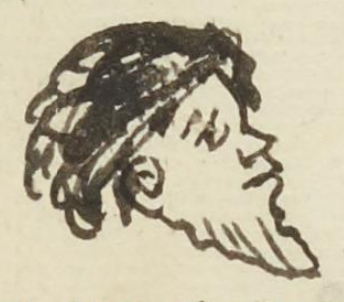Tentzon (MH640v)
This black-line drawing of the simplex glyph for the personal name Tetzon ("Beard" or possibly "Offspring") attested here as a man's name) shows the head of a man tilted back slightly. The hair {tzontli) on his head is pronounced. Also notable is his jutting chin with a significant beard (also tzontli).
Stephanie Wood
It is not at all unusual to have a letter "n" drop out of a gloss. If this name actually means "Offspring" ("Tetzon" and not "Tentzon") then the lips and hair would serve as a fully phonographic compound.
Beards were known in the autonomous era (as this Olmec sculpture found in Puebla shows, but beards became thicker and more prevalent as European DNA became a factor as a result of colonization (whether as a result of violation or through consensual unions). Nahua and European views of hair were very different and affected how they perceived one another. For a study of some of these attitudes, see A. Turner, "Beard and Conquest," Revista de Historia Iberoamericana 6:1 (2013). The beard in this glyph seems especially black, thick, and long.
Wikipedia notes: "In the 15th century, most European men were clean-shaven. [But] 16th-century beards were allowed to grow to an amazing length (see the portraits of John Knox, Bishop Gardiner, Cardinal Pole and Thomas Cranmer). Some beards of this time were the Spanish spade beard, the English square cut beard, the forked beard, and the stiletto beard. In 1587 Francis Drake claimed, in a figure of speech, to have singed the King of Spain's beard." See below for an image of a forked beard.
Stephanie Wood
tentzō
Tentzon
Stephanie Wood
1560
Jeff Haskett-Wood
beards, barbas, hair, pelo, cabello, faces, caras , nombres de hombres, tetzon, tentzon, tetzontli, tentzontli

ten(tli), lip, edge, https://nahuatl.wired-humanities.org/content/tentli
tzon(tli), hair, beard, https://nahuatl.wired-humanities.org/content/tzontli
La Barba
Matrícula de Huexotzinco, folio 640v, World Digital Library, https://www.loc.gov/resource/gdcwdl.wdl_15282/?sp=363&st=image.
This manuscript is hosted by the Library of Congress and the World Digital Library; used here with the Creative Commons, “Attribution-NonCommercial-ShareAlike 3.0 License” (CC-BY-NC-SAq 3.0).





